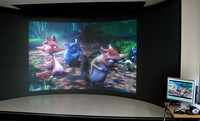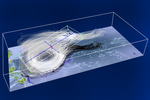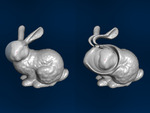If you are working on an application based on Equalizer, please drop us an email and we will add your program to the list.
RTT Scale
RTT Scale is the scalability module for RTT DeltaGen and RTT DeltaView plus. RTT Scale uses Equalizer to boost OpenGL and ray-tracing performance on highly realistic, complex scenes. Please visit http://www.rtt.ag for more information. Image copyright Realtime Technology AG, 2008.
Bino: a 3D video player with multi-display support
Bino is a video player with support for 3D (stereo) videos and for multi-display installations, e.g., for powerwalls, Virtual Reality installations and other multi-projector setups. It supports video synchronization across multiple GPU's in the same system or in a cluster.
Bino uses the Canvas and Layout information of any Equalizer configuration to align the video. This enables an intuitive configuration of one or more display walls (canvases) with overlap or underlap as well as mixed mono, active, passive and anaglyphic stereo (3D) projections from a single application. The individual displays or projectors (segments) can easily be mapped to different computers, GPU's and output areas. Detailed technical documentation is part of the BINO distribution.
Omegalib
Omegalib is a middleware designed to ease the development of applications on virtual reality and immersive systems. Among other things, it is used to run applications in the CAVE2., which is approximately 24 feet in diameter and 8 feet tall, and consists of 72 near-seamless passive stereo 3D LCD panels, a 36-node high-performance computer cluster, a 20-speaker surround audio system, a 10-camera optical tracking system Its main features are:
- Support for hybrid systems, presenting high definition 2D and 3D content on the same display surface
- Display system scalability
- Support for a wide range of input peripherals (controllers, motion capture systems, touch surfaces), through the Omicron toolkit
- Integration with third party higher level toolkits like Unity, vtk, OpenSceneGraph, Qt.
Computer Graphics and Multimedia Systems, University of Siegen
Hase3d: Hardware accelerated flow visualization
The hase3d project bundles a set of techniques for the interactive evolution and visualization of various flow primitives, i.e. particles, lines and surfaces/volumes. Using the Equalizer framework, the application has been extended to multi-node rendering in order to immerse the user into the virtual reality cave at the University of Siegen.
The cave consists of a cylindrical projection area composed of six (stereo) projectors (four front, two floor). An enhanced interactivity is achieved by introducing head and object tracking to the user interface.
The flow-vis module visualizes a typhoon simulated by the DKRZ Hamburg. Direct visualization techniques help climate researchers to explore flow characteristics by controlling the visual output.
The surface evolution module features arbitrary deformations preserving volume and allowing topological changes. This is used for interactive object modelling in the VR application.
CompCore at CSU East Bay
The California State University, East Bay uses Equalizer for point-based rendering of LIDAR data, force-directed graph layout and panoramic image viewing on a 40-core cluster driving an immersive projected display system.
eqSmart: Terrain rendering
eqSmart is a port of the Smart terrain rendering software. Smart is based upon the Ogre3D graphics engine. Support for database decomposition was not implemented. eqSmart will be superseded by eqRaster, an OpenGL-based terrain visualization engine.
eqSmart is not publically available due to licensing issues.
eqOgre and eqOgreBullet: Ogre/Equalizer/Bullet integration
eqOgre is a fully functional integration of the Ogre3D graphics engine with Equalizer.
eqOgreBullet adds the Bullet physics library to eqOgre making it useful as basis for a game engine.











